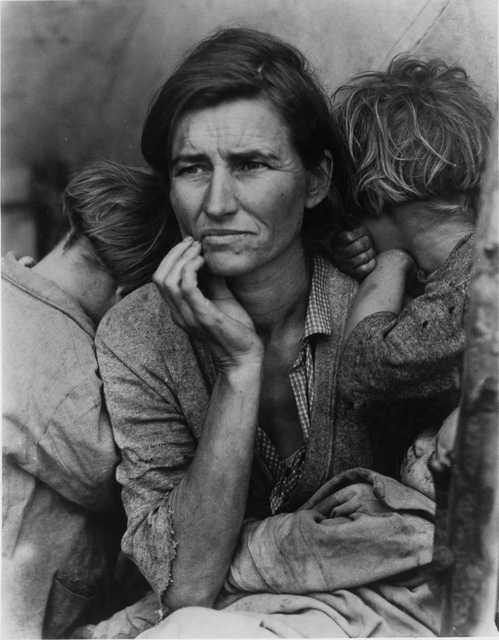The Farm Security Administration (FSA)! What do you think this USDA agency did? Let me guess. It was a federal police force that patrolled farms to make sure no cattle were being rustled or barns were broken into. Farmers would post signs like the one below to show that their farms were protected by the Farm Security Administration.

Figure 1. Farm Security Administration Logo
My guess would be wrong. So, what do you think the Farm Security Administration did?
In the past several Friday Footnotes we have explored the various programs operated by the depression era Resettlement Administration (RA). These included Subsistence Homesteads for urban dwellers, Resettlement Centers for Dust Bowl refugees, and Planned Farming Communities for displaced farmers. However, there was intense public and congressional criticism of some of these activities because of what the Farm Bureau labeled collectivizing agriculture. Terms such as socialism and communism were used in describing these Resettlement Administration programs.
So, what do you do when public opinion is against you or the public has misperceptions about an organization or program? You rebrand. You change your name. We now have the National FFA Organization instead of the Future Farmers of America. Vocational Education is now Career and Technical Education. Hence, the Resettlement Administration was rebranded and became the Farm Security Administration.
The passage of the Bankhead-Jones Farm Tenant Act in 1937 provided the perfect excuse to abolish the Resettlement Administration and create something new. The purpose of this law was to provide long-term loans to farm tenants and sharecroppers, to provide short-term loans to other farmers for “livestock, equipment and supplies,” and to purchase land no longer fit for agricultural use and then utilize that land for other, more suitable purposes. It also carried on the various resettlement programs of the RA. Basically, the Farm Tenant Act merely codified programs that were already occurring under emergency relief acts and the Resettlement Administration. The promotion of farm ownership was the truly novel aspect of this legislation (Bankhead-Jones Farm Tenant Act, 1937). Tenant farmers and sharecroppers had felt they were left out of the previous New Deal relief efforts.
The Farm Security Administration continued the various programs of the Resettlement Administration but become more active in loaning money and establishing coops. However, the program that garnered the FSA fame was the photography unit.
The FSA Photography Unit
The FSA photography unit was started during the short life (1935-1937) of the Resettlement Administration. To help combat criticism from legislators and press, the RA Director, Rexford Tugwell, created a publicity department that specialized in photography but oddly enough was known as the “Historical Section.” [Curator’s Note: Tugwell was an economist at Columbia University who joined Roosevelt’s first Brain Trust. Many newspapers ridiculed Tugwell and other members of the Brain Trust who were primarily Columbia University academicians, as “impractical idealist.” Tugwell was called “Rex the Red” and resigned from the Roosevelt administration in 1936].
Before leaving the RA, Tugwell created the photography division and was soon sending photographers out across the nation to record both the need for the RA programs and their effects. This photography program continued in the Farm Security Administration as the Information Division and received national acclaim for their work in documenting the depression.
Probably the most widely used image of the great depression was that of the Migrant Mother (see below). It was taken in Nipomo, California in 1936 by Dorothea Lange, one of the FSA photographers.

Figure 2. The Migrant Mother was taken by Dorothea Lange.
The name of the mother was Florence Owens Thompson. She and her children were in a camp filled with field workers whose livelihoods were devastated by the failure of the pea crops. Recalling her encounter with Thompson years later, Lange said, “I saw and approached the hungry and desperate mother as if drawn by a magnet. I do not remember how I explained my presence or my camera to her, but I do remember she asked me no questions. I made five exposures, working closer and closer in the same direction. The exposure above from that shoot, now known as Migrant Mother, was widely circulated to magazines and newspapers and became a symbol of the plight of migrant farmworkers during the Great Depression (MOMA, n.d.). The first exposure of the five is shown below.

Figure 3. First of five photographs of the Migrant Mother taken By Dorothea Lange.
Dorothea Lange was one of twelve FSA photographers. The others were:
| Jack Delano | Walker Evans | Carl Mydans | Gordon Parks |
| Arthur Rothstein | Russell Lee | John Vachon | Marion Post Wolcott |
| Theo Jung | Ben Shahn | John Collier |

Figure 4. An image of Dorothea Lange. Note the size of the camera.
These twelve photographers played a significant role in documenting life in the 1930s. They covered the country taking photos. Their images are regarded as national treasures. This extraordinary group of men and women comprise a virtual “Who’s Who” of twentieth-century documentary photography. Many later forged careers that helped define photojournalism at magazines like Life and Look. While most of the FSA photography focused on the south and west, they also documented mining towns in Pennsylvania, slum housing in Chicago and Washington D.C., and rural life in Ohio, New England, and upstate New York. They studied the lives of migrant farmworkers in Michigan and the homes of packinghouse employees in New Jersey. They took 250,000 images of rural poverty. Fewer than half of the images survive. They are housed in the Prints and Photographs Division of the Library of Congress.
A sampling of the photos taken by the FSA photographers (and others) can be found at https://photos.legendsofamerica.com/vintagephotographers. Most of the FSA photographs are found in the Library of Congress. The URL is http://www.loc.gov/pictures/collection/fsa/. The site has a searchable index. You can search by the name of the photographer (Dorothea Lange yields 3,940 images) or subject such as plowing, Future Farmers, poultry, vocational education, sharecropper, 4-H, etc. Below are four samples of images found in the Library of Congress FSA collection.

Figure 5. Vernon County, Wisconsin. Robert Saugstad with vocational agriculture students studying the new Farmall tractor

Figure 6. 4-H Club members give their club pledge at Pie Town, New Mexico

Figure 7. Plowing at Gee’s Bend, Alabama

Figure 8. Swapping stories in Jeanerette, Louisiana
The War Years
With the outbreak of World War II, the focus of the FSA photo project began to change. As the nation’s attention turned from economic and social issues at home to the war against Germany, Italy, and Japan, the photo unit reflected this shift. FSA photographers were encouraged to take more “positive” images of American life to bolster America’s war effort. And while FSA photographers continued to document poverty and inequality, they were told to increase their output of photographs featuring reassuring images of American life. Pictures of defense factories, war workers, and patriotic activities on the home front also began entering the FSA files.
In October 1942 the FSA photo unit became part of the new Office of War Information (OWl), created to direct America’s wartime propaganda efforts. The following year the unit formally went out of existence. and a few FSA photographers went to work for the OWI.
Concluding Remarks
There is an old saying that a picture is worth a thousand words. The Information Division of the Farm Security Administration proved this. I could spend hours looking through the images taken by the FSA photographers. They speak reams about what life was like in rural America during the 1930s.
During my years of supervising student teachers, one thing that irked me was when the student teacher had a PowerPoint presentation that was all words. You might as well write these words on the board. The power of PowerPoint is the ability to use images. Many of our students are visual learners and learn best when there are images associated with the words. You might want to bookmark the Library of Congress FSA gallery. Nuff said.
The Farm Security Administration ceased to exist in 1946 and became a part of the newly created Farmers Home Administration.
This Friday Footnote concludes the series of Footnotes that have focused on farm policies of the 1930s. Many of the initiatives of the 1930s such as soil conservation, farm credit, agricultural commodity price supports, rural electrification, farm loans, etc. are still with us today.
Next week we return to the smorgasbord of Footnote topics. Dr. Jim Connors will be our guest columnist and will look at the aims and purposes of the FFA. You have something to look forward to.
Teaching Ideas
Show the video “Sights and Sounds of the Farm Security Administration”. It is 13 ½ minutes long but is well worth watching. No matter what courses you teach, you should make a concerted effort to show this video. It uses photographs from the FSA photographers and tells about the work they did and the Great Depression and Dust Bowl. Social injustice is briefly touched on. There are also audio recordings of songs from the refugee camps. https://www.youtube.com/watch?v=MRZwlF5-89Y.
Give your students the URL to the Library of Congress FSA photographs and have them search for images related to one of their interests. They should select 1-3 images, put them in a PowerPoint, and explain to the class why the selected those images. http://www.loc.gov/pictures/collection/fsa/
Describe the Information Division of the FSA and tell about their mission. Then ask your students to assume the role of an FSA photographer and take images in their community as if they were an FSA photographer. Have them share their images with the class.
Select four different images taken by FSA photographers and have a “judging contest” where students place the four images and give reasons.
If you teach agricultural communications, have your students research one of the eleven FSA photographers, and report on that person. There are two females and one African American in the group.
References
Bankhead-Jones Farm Tenant Act, 1937. https://livingnewdeal.org/glossary/bankhead-jones-farm-tenant-act-1937/
MOMA, https://www.moma.org/learn/moma_learning/dorothea-lange-migrant-mother-nipomo-california-1936/
